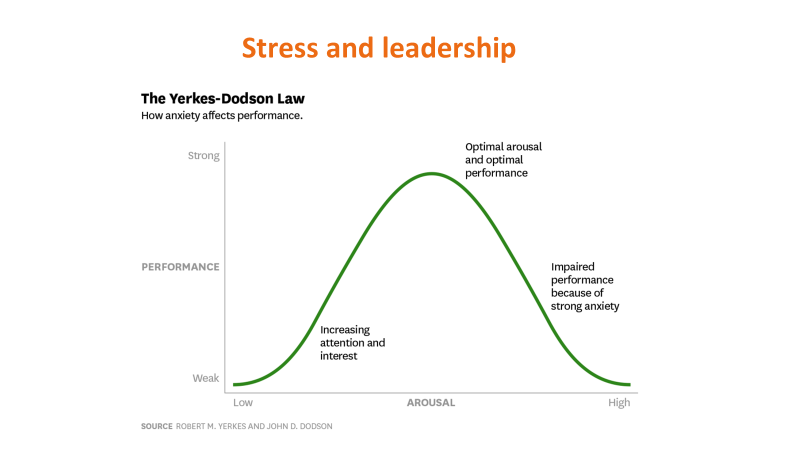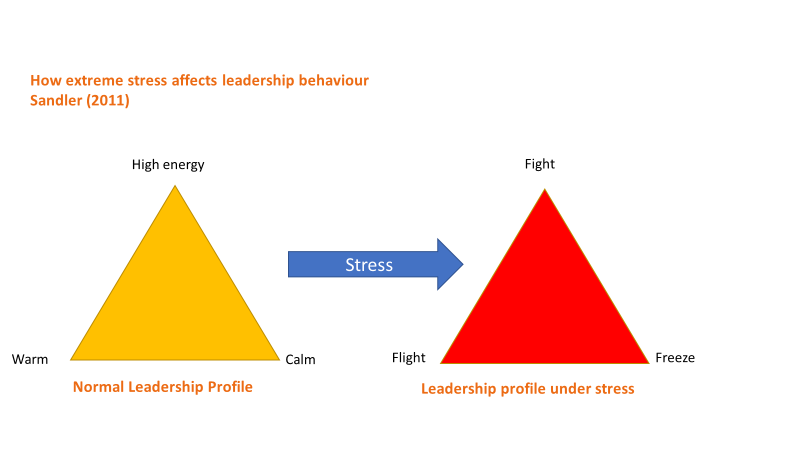
This article is also available as a podcast; listen below or download here.
*
How is all the stress and pressure of the coronavirus crisis affecting you? Do you find yourself getting a bit less patient with those you manage? Or, perhaps you are withdrawing into the data and avoiding communicating with people? Or maybe you feel paralysed and you just don’t know what to do for the best?
How extreme stress changes leadership style
During a crisis like the present national emergency, most of us feel some degree of anxiety, fear and overwhelm. This is especially so if you are a leader where the decisions you make impact on the lives of others. All leaders have their own distinct style: some are charismatic and lead from the front, others are more analytic and reflective and some are great team builders.
But, how might your particular style of leadership be affected by having to lead under extreme stress?
How does stress affect performance?
In 1908, two psychologists, Robert Yerkes and John Dodson, studied the relationship between stress and performance (Yerkes, R. M. & Dodson, 1908)[1]. They developed a model that has become a classic in psychology - the Yerkes–Dodson curve (fig.1).

Figure 1: the Yerkes-Dodson Curve
This graph shows the relationship between how stressed you feel and how well you perform at a task. It shows that when stress is low, performance is correspondingly low. In other words, if you’re bored and there’s no challenge or stimulation at work, then the quality of your work is likely to be poor. However, as stress increases, so does performance. Stress can be very constructive – but only up to a point. At the top of the stress curve is optimal performance.
But what happens if stress continues to relentlessly increase? We can see from the Yerkes–Dodson curve that, performance rapidly drops off, eventually becoming poor. When this happens consistently, it results in burnout.
Leadership style and extreme stress
There are three effective styles of leadership:
- Charismatic, high-energy and task focused leadership.
- Warm inclusive, and teambuilding leadership.
- Calm, logical, reflective, and analytic leadership.
Most leaders will move between these styles but will have a strong preference towards one.
However, what happens when the leader is under extreme pressure?

Figure 2, leadership style and stress
The organisational consultant and coach, Catherine Sandler looked at how leaders respond to extreme pressure[2].
The coronavirus crisis confronts leaders with relentless pressure, uncertainty and change. They have to make tough decisions to keep their organisations functioning, as well as finding ways to motivate employees who feel unsettled, confused, and often scared.
When leaders feel threatened or overwhelmed, they react like all human beings; by shifting into freeze, flight or fight mode. This process is triggered instantly, outside our conscious awareness, before the rational part of our brain is even aware of a problem. How this manifests in leadership style is shown in the second triangle, in Figure 2.
Charismatic leaders bring passion to their role. However, when the pressure becomes too much, they go into fight mode. The main driver of their anxiety is fear of loss of control, linked to their need to achieve. As adrenaline floods their bodies, their capacity to control their own behaviour is reduced. Their energy spills out in the form of angry outbursts, impatience and excessive criticism,
Warm and inclusive leaders also bring emotional energy to their leadership, focussing on achieving results through enabling others – building teams and nurturing talent. When these relationship-focused leaders are exposed to excessive pressure, they go into flight mode. They fear losing the approval of others, which can result in avoiding conflict or difficult decisions and not standing their ground on an important issue. This creates insecurity and frustration. Sometimes in-fighting occurs to fill the power vacuum.
Calm, analytical leaders do not bring a high level of emotion to work. Instead, they are steady, rational and objective, unflustered in a crisis, respected and relied upon by others.
When they feel overwhelmed, they go into freeze mode. The main driver of their anxiety is a fear of being emotionally overwhelmed. As a consequence, they withdraw emotionally and often physically, and are experienced as being remote, uncommunicative and uncaring.
We have all observed these traits in bosses that we have worked for. What’s easy to see in other people, is sometimes more difficult to see oneself.
We need good leadership now, more than ever. If you are a leader, spend some time reflecting on your leadership style, how you might be being affected by the crisis, and how you might keep your leadership style effective.
You need to be part of the solution, not part of the problem.
Dr Michael Drayton
[1] Yerkes, R. M. & Dodson, J. D. (1908). The Relation of Strength of Stimulus to Rapidity of Habit-Formation. Journal of Comparative Neurology and Psychology, 18, 459–482.
[2] Sandler, C. (2012), The emotional profiles triangle: working with leaders under pressure, Strategic HR Review, Vol. 11 No. 2, pp. 65-71